Correct and incorrect composition
It is important to select the substrate, clearly focusing on the interests of the indoor plant. Epiphytic varieties need a light, quickly drying soil, and terrestrial ones prefer a denser, moisture-consuming substrate.
That makes all the difference.
Correct orchid mix:
- pine bark (how to pick or prepare bark for an orchid?);
- ash;
- moss;
- coconut peel;
- compost;
- peat;
- perlite;
- humus;
- deciduous land.
The last five ingredients are used for terrestrial varieties. The wrong composition is collected by eye, contains garden soil and is flavored with numerous dressings. Perhaps, after such an orchid cannot be reanimated.
What does the substrate for orchids consist of?
Orchid substrate can consist of different fillers, I will talk about them in more detail below. But when choosing a blank in a store or self-assembly, it is worth remembering the main tasks that the mixture should solve:
- Absorbs moisture well. This is necessary for the uniform return of water to the plant and the removal of excess liquid.
- Dry quickly to prevent roots from rotting.
- Allow enough air to keep conditions close to natural.
- Saturate the environment with nutrients.
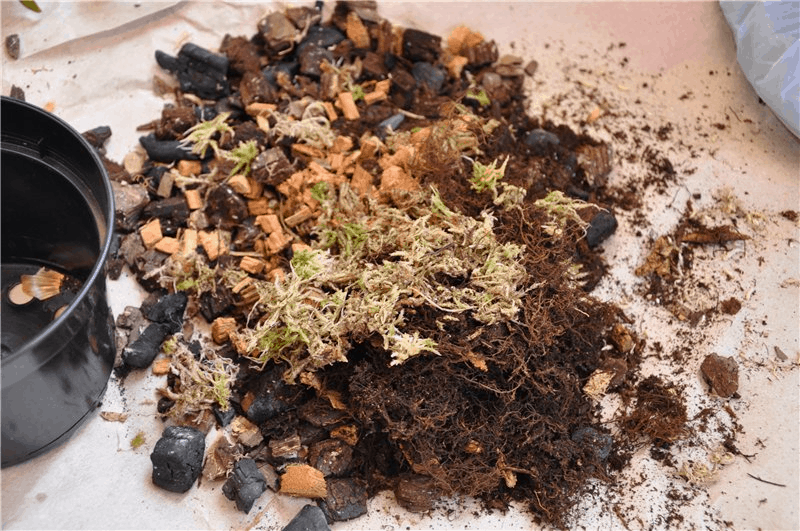
Stores often sell ready-made bark-based mixtures for orchids. They meet the basic requirements and are used successfully by many breeders. The main risk is that the substrate can cake and deteriorate during storage. Also, the industrial method of harvesting is not able to provide a sufficiently careful selection of the bark, so the set will contain pieces of different quality.
Orchid bark

The main filler for orchids is the bark. Pine is the most commonly used - it is light, absorbs moisture well, dries quickly and is widely available. It is easy to find and prepare it. However, you can find mixtures based on other species: spruce, larch, oak bark. The main thing here is the correct collection and processing of the material.
So what kind of bark is needed? If we talk about conifers, then here the bark is best collected from already dead, dried trees, so it will contain less resin. It is imperative to choose areas that are not damaged by the sun, rot, or pests. For adult orchids, the particle size is about one centimeter long and wide.
Important ingredients are moss and coal
However, the bark for orchids, although the main, is not the only necessary filler. If you are using pre-made substrates, make sure there are other elements in them as well. Add them separately if necessary. The most basic components are the following:
- Sphagnum moss,
- Charcoal.

Sphagnum is the most common moss in Russia. For growing orchids, it is used both live and dry. Thanks to its structure, it provides sufficient ventilation for the roots. It is also able to absorb a large amount of moisture, performing two functions at once: it retains water and evenly gives it to the plant, and also protects the aerial roots from decay.
In addition, moss contains a large amount of nutrients that orchids need. In addition to sphagnum, you can use other types, for example, cuckoo flax. The main thing to remember is that dry mosses decompose quickly, and therefore they need to be changed at least 2 times a year.

Charcoal - most often birch - is used as an absorbent: it absorbs harmful substances such as excess salts. Small pieces of the same size as the bark for orchids are added to the pot - 1-2 cm in diameter. It is advisable to replace the coal periodically.
Other components
In addition to the main components of the substrate: pine bark, moss and charcoal, other components are sometimes added. The following additives are common in Russia:
- Horse peat. It is breathable and can absorb a lot of moisture. However, in the future, you will have to deal with excessive soil acidity, and also look for additional sources of nutrients. This supplement is good for mature and strong plants.
- Cones, nutshells, dry fern roots serve at the same time as a baking powder, mulch for better ventilation of the roots, and a source of useful micro- and macroelements. From exotic, coconut fiber is also suitable.
- Fallen leaves, rice husks. When decomposing, these components will provide the orchid with additional feeding.
Inorganic components
Also, inorganic components can be added to the mixture from the bark for orchids, such that they will be chemically inert, while making the substrate looser. Some materials also retain moisture well. Most often they add:
- Coarse sand - it makes the soil lighter.
- Expanded clay, perlite and vermiculite are used as additional drainage.
- Styrofoam and foam are also great for loosening and retaining moisture.
What kind of soil is this?
- Seramis is an innovative development of a German company. In essence, this is a clay soil, and it is completely universal. Seramis of natural origin, it has no expiration date and works for indoor and garden plants. A unique development acts as an automatic watering, can be used several times and even after diseased flowers.
- In addition, it provides completely comfortable plant care - you can forget about dirt from the ground, unpleasant odors and insects, which are often bred. Seramis is also good for houses with pets - they are less likely to throw it around.
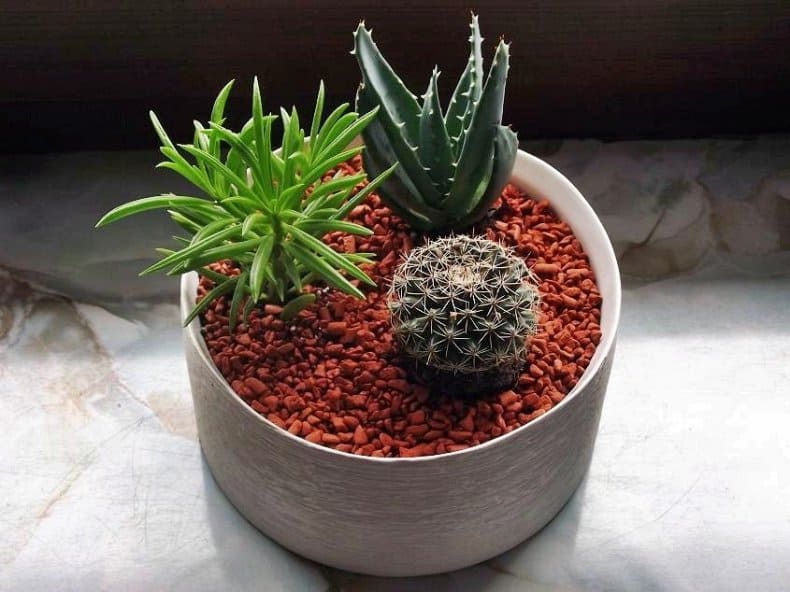
- So what is it and where does it come from? A unique product has been developed in Germany for about 30 years. It was made and continues to be made from German, Italian and Portuguese raw materials. The development instantly became popular in space - in Europe Seramis began to be used literally everywhere, but in the CIS countries it appeared relatively recently and often raises questions and doubts.
- In essence, Seramis is the same soil, just very “smart” and versatile - it suits almost any plants. It looks like small porous granules of orange, clay shade. It is this structure that allows any plants to take root and feel good.
- Seramis gives the roots the ability to constantly breathe and gain enough oxygen and works as an autonomous autowatering system - the granules absorb water, but do not give it away immediately, but are adjusted according to the plant. Due to this, plants with different irrigation regimes can grow in one pot.
"Ambulance"
Like many nutrient substrates, it has mixed reviews and recommendations. Is this due to the poor quality of the manufacturer or fakes? But, if you manage to purchase a quality batch, then the florist will not be disappointed. The popularity of Ambulance is above average.
 A nutritious substrate suitable for all types of orchids. Based on:
A nutritious substrate suitable for all types of orchids. Based on:
- High peat;
- Plus bark (pine).
The advantages, according to the manufacturer, include:
- Provides a good microclimate inside the flower container;
- It has a good effect on plant survival after transplantation;
- Provides resistance to disease, stress and enhances immunity;
- Improves decorativeness;
- Removes the harmful effects of fertilizers and other soil substrates;
- It has a good effect on the development of beneficial microflora, and also helps to eliminate harmful ones.
The manufacturer guarantees:
- Cleanliness;
- Naturalness;
- And the safety of the composition.
Contains a full set of micro and macro elements necessary for the full development and growth of orchids.
Advice! It is better to use it as a component in the manufacture of the substrate yourself.
Description of soil
Of course, in order to get a high-quality substrate, selected in individual proportions, cook yourself
Otherwise, pay attention to the following ready-made mixtures:
- "Bio start effect" made in Russia. The mixture is made exclusively from natural, organic ingredients. Fine-grained soil, grain size 8-13 mm. The substrate does not need disinfection, it is completely ready for use. The cost of a 2 liter package is 350 rubles.
- "Gardens of aurica" for the orchid professionals. The soil mixture consists of: wood ash, bark, moss, coconut chips. Also, the composition includes vermicompost, which in such a volume does not benefit the plant, and there is a scanty amount of bark. The volume of the substrate is designed for a pot with a capacity of up to 1.7 liters. As a drainage, you can use coconut fiber, which is included in the kit. The cost of the set is 100 rubles.
- Seramis is a planting mixture specially developed for orchids. The composition contains coarsely fractionated expanded clay granules, pine bark and additional micronutrients. The substrate provides the necessary air exchange, promotes active growth, and maintains water balance. The price is 950 rubles. Soil content in the package is 2.5 liters.
In order to make the right choice and buy the best soil for an orchid, study the quality criteria for ready-made soil mixtures.
Transplant and care features
When purchasing Seramis soil for the first time, the florist asks questions:
- How to plant a plant in it correctly;
- And what kind of care you need for it with its further growth.
Step-by-step planting instructions
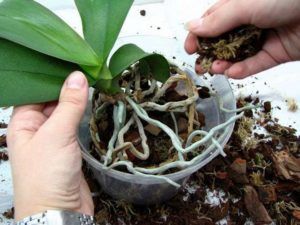 Planting of orchids in Seramis is carried out according to the already familiar technology. Let's find out what you need to have for this. Instrument for the transplant procedure:
Planting of orchids in Seramis is carried out according to the already familiar technology. Let's find out what you need to have for this. Instrument for the transplant procedure:
- Sanitized pruning shears with sharp blades;
- The necessary size of a pot with transparent walls;
- Seramis;
- Preparations for processing slices on an orchid.
Plant transplant process:
- So that the plant does not damage the root system, it must be watered with a warm shower before removing it from the old container. Wet roots are less brittle;
- The old soil is shaken off, which is sprinkled is good, it is not specifically necessary to tear off the old soil from the root mass;
- Examine the root system for pests and rotten spots. If any of this is found, appropriate processing must be carried out. Pests can be poisoned with Aktara or Aktellik. Rotten places are surgically disposed of, cutting out rotten places and not forgetting to process the sections with cinnamon or charcoal;
- After processing, start planting. An orchid is placed in the center of the container and the voids are filled with Seramis substrate;
- After all treatments and, even if they were not, the roots are dried within 8 hours after transplanting. Since during planting, even on a healthy root, fractures may appear and, if water gets in, decay will begin in that place. Therefore, drying is necessary.
IMPORTANT! When filling the pot with a substrate, it does not need to be tamped, so as not to damage the root mass. It is simply placed in such a way as to firmly fix the flower in the pot.
Watering
There are no new conditions for caring for the plant. The exception is watering. The first is desirable to be carried out 4 days after disembarkation. Further watering, on average, occurs once every 20 days, or, if the weather is hot, you should focus on the color of the root system.
Top dressing
The Seramis soil contains the necessary fertilizers, so if the plant is transplanted in the spring, then it will have enough fertilizer for the vegetative season, and then the flowering season begins and the plant does not need fertilization.

Having transplanted the orchid, they begin to feed it only after the flowering period.
They start feeding only the next year after the end of the flowering season.Top dressing is applied in the usual way: after watering on a wet root system. This is done in order not to burn the root system. The frequency of fertilizing is 2 times a month with specialized fertilizers for orchids. In this case, the preparations are diluted with twice as much water as indicated on the package.
Reuse
The substrate can be used several times, and when transplanting into a larger container, you just need to add the substrate to the required volume. If the plant has died in it, then the substrate is disinfected in the oven at a temperature of 200 degrees for 20 minutes and continues to be used further.
IMPORTANT! When using it again, it is imperative to disinfect the substrate.
What is Seramis
The main advantage of the artificial substrate Seramis is that it is a very unfavorable environment for the development of fungal diseases and pests.
It is also important that the pores in young clay are relatively large, so Seramis is not very picky about the quality of irrigation water. If hydrogels and zeolites from watering with hard water deteriorate after a few years, then Seramis to be regenerated will last for the whole life of both the plant and the grower.

Composition of the Seramis complex for indoor plants
The base of Seramis is carefully selected, dried, then elutriated (purified by settling in water), again dried, annealed and granulated red ribbon clay. Seramis granulate is produced in several types, depending on its purpose. General purpose Seramis substrate (pos. 1) in fig. acts as a porous accumulator of moisture without any intricacies: it is quickly saturated with moisture and slowly releases it, so that the plant does not risk being overfilled, but does not experience an urgent need for moisture for a long time. In Seramis for orchids (pos. 2) add the bark of Mediterranean pine and a complex of basic nutrients NPK (nitrogen-phosphorus-potassium), the ratio of the components of which is designed to force the flowering of plants. Raw materials of Seramis for succulents (pos. 3) undergo a deeper roasting, which makes the granulate itself darker, its moisture capacity somewhat decreases, but the time for the release of moisture lengthens to a month or more. Seramis for palms (pos. 5), on the contrary, is annealed at a low temperature, which makes its moisture capacity increase, but the time for the release of moisture is reduced. In addition, the entire Seramis system includes specialized compound fertilizers (pos. 5, and see below) and a moisture indicator, pos. 7.
Not so simple
"Simple" Seramis does not contain any additives and retains the natural color of the raw materials. Its volumetric moisture capacity is approx. 0.25, i.e. 1 cubic meter dm. loose, non-tamped substrate absorbs 0.25 l (250 ml) of water. Moisture release time - 7-14 days, depending on the outside temperature. General purpose seramis is divided into 3 subspecies of different granule sizes.
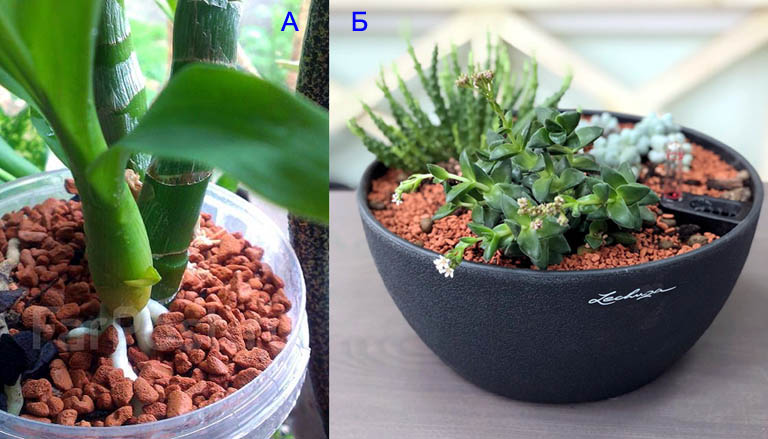
General purpose Seramis substrate of different granule sizes
Large-granular General Purpose Seramis is suitable as a substrate for relatively undemanding orchids (pos. A in the figure; also see below) and large indoor plants. It goes on sale under the Orhidan designation. Medium granular - really general purpose, it is suitable for most common indoor plants; phalaenopsis can be grown from orchids in it. Recently, saintpaulia (uzambara violet) has been successfully grown on "simple" Seramis, see video:
Video: about Seramis for violets
Fine-grained Seramis (pos. B in the figure above) is a specialized substrate for bonsai mini-compositions of succulents. If you transplant orchids into it, they will feel bad and will soon "ask" back into the bark, see, for example, the plot:
Video: orchids did not take root in "small" Seramis
Regeneration
The general purpose Seramis substrate is subject to regeneration and further use, even if taken from a diseased dead plant.Regeneration of Seramis, which almost completely restores its moisture exchange qualities, is carried out in this way:
- Rinse in 3-4 changes of tap water to remove dirt from the surface of the granules;
- Bake in the oven for half an hour at maximum temperature;
- Boil for 15-20 minutes in clean soft water (distilled or purified rainwater, see below);
- Remove from cold water with a colander, transfer to another dish;
- Fill with cold water, also clean and soft;
- Allow to cool to room temperature;
- Drain the water, and sprinkle the substrate in an even layer on a clean film and dry it not in direct sunlight.
Orchid
Specialized Seramis for orchids cannot be regenerated due to its composition, see below. But in it, with proper planting and care, almost all orchids that have taken root in the rooms feel comfortable: wanda, dendrobium, cattleya, miltonia, and, of course, phalaenopsis, see the video:
Video: Seramis for orchids
The composition of Seramis for orchids includes:

Artificial substrate Seramis for orchids
- Large-granular general purpose seramis - 35% by weight (20% by volume).
- Pine bark - 35% by weight (50% by volume, see the figure on the right).
- Solutions of the main nutrients with which the granules are impregnated - 30% by weight (N - 18 mg / l; P - 55 mg / l; K - 180 mg / l).
Phalaenopsis orchid soil: main components and their characteristics

The correct soil is essential for the full development of orchids.
The land for phalaenopsis is called a substrate and its choice is of decisive importance for the full development of the plant.
The composition is determined by the climate at the place of cultivation - temperature, humidity, light.
The structure and components are selected both in terms of conditions and hybrid characteristics, flower size, capacity characteristics, etc.
Only lush flowering and development will give the answer to the correctness in the selection of the composition of the substrate.
The composition or mixture may include the following components:
- Bark of trees;
- Sphagnum moss;
- Coniferous cones;
- Charcoal;
- Vermiculite, perlite and expanded clay;
- Styrofoam;
- Peat;
- Fern roots;
- Fiber from coconut, etc.
In modern flower shops, a specially selected composition for orchids is available for sale.
But everyone, in principle, can prepare it on their own, observing certain rules and recommendations.
Unlike natural components, synthetic ones have more disadvantages that should be paid attention to when choosing and preparing a soil mixture. When using polymers, it is worth knowing that under the influence of light, elements contained in air and water, decomposition processes occur, as a result of which a free form of styrene is formed.
When using polymers, it is worth knowing that under the influence of light, elements contained in air and water, decomposition processes occur, as a result of which a free form of styrene is formed.
And he, in turn, penetrating the roots, causes considerable harm to the plant.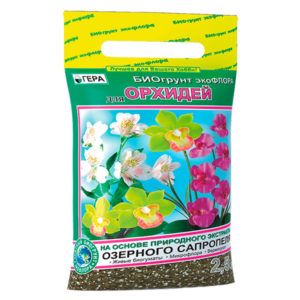
In most cases, modern hybrid forms of phalaenopsis are not very demanding on the traditional composition of the soil.
But still, each one reveals its hybrid characteristics as much as possible, while observing certain proportions and composition of the components.
The soil, or as specialists call it - the substrate, must meet certain requirements:
- Be light;
- Moisture-intensive;
- Breathable;
- Loose.
Important! The main purpose of the soil is to create plant resistance, close to the natural environment.
Orchid growers use pine bark as the main component of the substrate, which has good aeration and moisture capacity.
Types of soil for phalaenopsis
There are many types of orchid primers on sale. Eat with natural ingredients, or with artificial ingredients or a mixture of them. Completely different proportions in the compositions.
It is very difficult for beginners to decide what kind of soil is needed with such a choice, but doing it yourself can be laborious or there is simply not enough desire.
It is important to know the characteristics of your plant and understand the purpose of each component of the substrate and understand the proportions
Proportions
The proportions are determined by the conditions of the growing site.
- At high humidity, you can do with only one pine bark with a small addition of charcoal, no more than 5%.
- With an average air humidity in the room (50-60%), sphagnum moss should be added to increase moisture capacity in proportions of 2 to 1.
- If the moisture readings are lower, then add moisture-consuming components in a ratio of 1 to 2.
Compositions
The composition of the substrate is also very diverse, but the bark remains the main components and very rarely some growers use leafy soil.
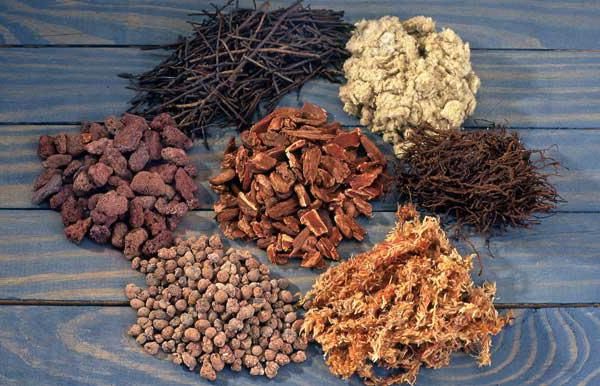
Various types of soil for Phalaenopsis orchids.
Composition is determined by understanding the existence of a plant in nature.
As an epiphyte, phalaenopsis does not require rooting, but grows due to symbiosis with woody crops.
At home, this function is performed by the bark, in which a large number of fungal cultures parasitize.
The rest of the components are of secondary, but still necessary, importance for full development.
What is the best soil?
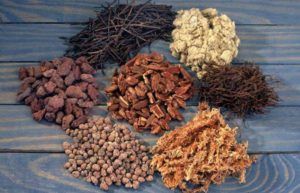 What substrate is needed for orchids? The substrate is selected in accordance with the type of flower, type of nutrition and characteristics of the root system.
What substrate is needed for orchids? The substrate is selected in accordance with the type of flower, type of nutrition and characteristics of the root system.
So, phalaenopsis, which have photosynthetic roots and need a transparent pot, require a simple, loose substrate that has high air permeability and moisture capacity.
As a soil for these varieties of orchids are used:
- Bark;
- Coconut shavings or blocks;
- Or a mixture of perlite;
- Sphagnum;
- Bark and coconut fiber.
For dendrobiums, a substrate is used:
- From pure bark;
- Either from the bark;
- And sphagnum.
Miltonias grow well in a mixture:
- Fine-grained cortex;
- Moss;
- Peat;
- Charcoal;
-
And perlite.
Cumbria prefer to grow in a substrate, the components of which slowly decompose and oxidize, therefore, mixtures of these orchids are used from:
- Peat;
- Moss;
- A small amount of bark;
- Charcoal;
- And expanded clay.
Cattleyas respond well to transplanting into a mixture of:
- Bark;
- And sphagnum;
- With a little charcoal acting as an antiseptic;
- Instead of sphagnum, you can choose coconut fiber.
Wanda reacts best to growth in clean pine bark, however, if the air in the apartment is dry, moss can be spread out on top, which is periodically sprayed, and this helps maintain the necessary humidity.
Comparative characteristics
The substrate, prepared independently, will be more carefully prepared, because you calculate the components, based not only on the preferences of the type of orchid, but taking into account the individual characteristics of the place of its further maintenance. The composition of the compo substrate is well suited for orchids.
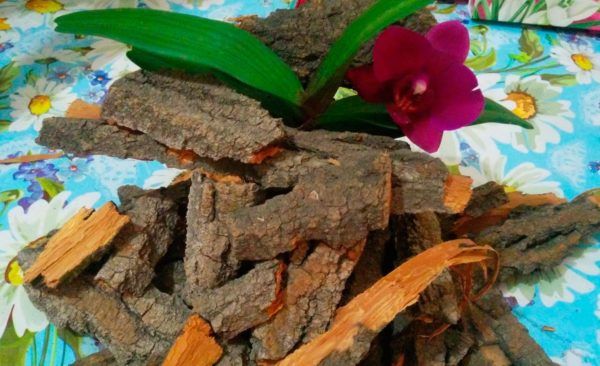
The best substrate is one that is made by hand.
So, with a lack of moisture, more sphagnum is added to the mixture, for example.
Important! For novice orchid growers, it is best to choose a ready-made soil that is balanced and formulated in the right proportions to avoid mistakes caused by lack of practical experience.
Large or small?
For large-sized plants, it is better to choose a soil with large and medium fractions, for small and dwarf varieties, a finer-grained substrate.
Advantages and disadvantages
| pros | Minuses |
|


